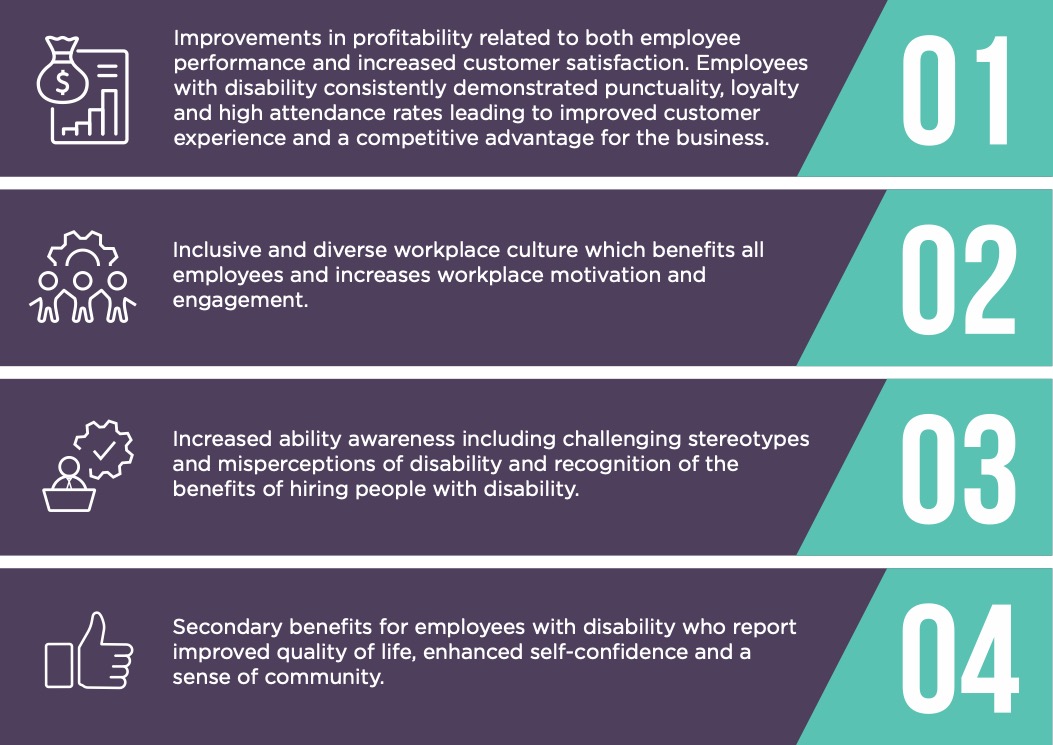Economic and Business Benefits of Employing People with Disability

Download the 'Economic and Business Benefits of Employing People with Disability' PDF guide (533 KB)
Download the ‘Economic and Business Benefits of Employing People with Disability' DOC guide (1.5 MB)
1. Overview
This factsheet provides information on the:
- benefits of employing people with disability for the economy
- benefits of employing people with disability for businesses and organisations.
2. Benefits for the economy
Decreasing the gap in labour participation rates between people with and without disabilities by one-third could result in an increase in GDP of $43 billion over a decade.
In 2011, Deloitte Australia conducted research into the economic benefits of increasing employment for people with disability in Australia.[1]
The economic modelling presented in the Deloitte report indicated that closing the gap between labour market participation rates and unemployment rates for people with and without disabilities by one-third could result in a cumulative $43 billion increase in Australia’s gross domestic product (GDP) over the next decade in real dollar terms.[2]
The modelling also suggested that GDP would be around 0.85% higher over the longer term, which was equivalent to an increase in GDP in 2011 of $12 billion.[3] These estimates only account for the direct impact on GDP, and do not include indirect effects from improved government fiscal balances and increased employment opportunities for carers.[4]
While this report was released almost ten years ago, the rates of employment for people with disability have not improved in this time.[5]
Employment can also provide increased income for people with disability to support their individual financial independence and capacity to contribute to the economy as consumers.
Ambassador reflection
“Being employed in jobs which support me financially to work on policy issues and advocate for the rights of my community has been hugely empowering for me as a young woman with disability and has given me a sense of self-fulfilment and purpose. In my personal life, the financial support also means that I can aim for similar goals to my non-disabled peers. There was a time in my life where I never thought I would have the financial capacity to have my own home and family as well as pay for the costs of my health; but my current employment has opened up those opportunities.”
Heidi La Paglia, Policy Officer
Women With Disabilities Australia
IncludeAbility Ambassador
3. Benefits for businesses and organisations
Employing people with disability has many business benefits.
People with disability have diverse perspectives, experiences, skills and talents. Evidence demonstrates that people with disability have a positive work attitude and work ethos, and that hiring people with disability can boost productivity and morale in the workplace.[6]
Research published in 2018 demonstrates that the benefits of hiring people with disability extend across the organisation or business.[7]
The systematic review of 39 international studies showed four key improvements including:
Diverse workforces reflect the diversity of a business’s customer base.
A diverse workforce, which includes people with disability, will better reflect a business’s surrounding community and customer base. It may also enhance a business’s image and brand among its staff, community and customers.[8]
People with disability often have very good problem-solving skills because they have regular experience adapting to challenges and finding creative solutions.[9] Hiring people with disability may support businesses to find innovative solutions to challenging problems, and create new, more efficient processes.
An inclusive workplace has benefits for the entire business.
A business which values and employs people with disability benefits from a more inclusive and positive work environment. This can include increased staff morale, improved co‑worker relationships and productivity across the organisation.[10]
Employing people with disability has also been shown to increase awareness of the skills and experience that people with disability bring to the workplace.[11] This contributes to building disability-positive workplaces and communities.
People with disability take fewer sick days, and incur fewer staff related business costs.
Studies have shown that people with disability take relatively fewer sick days than other employees, and are involved in fewer work, health and safety incidents.[12] In one study, people with disability accrued less than half the amount of ‘sick leave’ (now commonly referred to as personal leave) compared to the average employee.[13] While some people with disability have chronic conditions which require them to attend regular medical appointments, this is no different from other obligations in a person’s life, such as family responsibilities. In addition, the number of reported work, health and safety incidents was six times lower for people with disability, and the number of workers compensation incidents was four times lower for people with disability in comparison to that of an average employee.[14] Businesses have also reported that employees with disability are more punctual, reliable and conscientious in their work.[15]
Recruitment costs, such as hiring, advertising, training, and induction may also be reduced, given the lower turnover rate for people with disability.[16]
The following case study demonstrates the broad benefits for businesses if they take an active role in attracting and recruiting people with disability to join their workforce.
Getting to Equal: The Disability Inclusion Advantage report
Research released in 2019 suggests that businesses overlook people with disability at their own expense.
In Getting to Equal: The Disability Inclusion Advantage,[17] published by Accenture in partnership with Disability:IN and the American Association of People with Disabilities (AAPD), the disability practices and financial performance of the 140 companies participating in the Disability Equality Index were analysed.[18]
Companies that embrace best practice for employing and supporting more people with disability in their workforce outperformed their peers.[19]
The report also indicated that there are three main reasons that companies have not leveraged the talents of people with disability:
- a lack of understanding of the scope of the talent available
- a lack of understanding of the potential benefits
- misconceptions about the cost versus the return on investment of disability inclusion.[20]
Leading companies that are working successfully toward disability inclusion have also achieved tangible financial benefits.[21] For example, the research shows that leading companies were, on average, achieving:
- 28% higher revenue
- twice the net income
- twice the likelihood to have total shareholder returns that outperformed competitors.[22]
According to other research cited within this report, employees with disability also offer other tangible benefits to their organisations, including increased innovation, improved productivity and a better work environment.[23]
Endnotes
[1] Deloitte Access Economics, Increasing employment for people with disability (Report, August 2011).
[2] Deloitte Access Economics, Increasing employment for people with disability (Report, August 2011) 22. Note this estimated increase is cumulative to 2031.
[3] Deloitte Access Economics, Increasing employment for people with disability (Report, August 2011) 22.
[4] Deloitte Access Economics, Increasing employment for people with disability (Report, August 2011) 25.
[5] Australian Bureau of Statistics, Disability, Ageing and Carers: Summary of Findings (24 October 2019).
[6] Australian Chamber of Commerce and Industry, Employ Outside the Box: The Business Case for Employing People with Disability (2014) 7.
[7] Lindsay S, Cagliostro E, Albarico M, Mortaji N and Karon L, ‘A systematic review of the benefits of hiring people with disabilities’ (2018) 28 Journal of Occupational Rehabilitation 634-655.
[8] Australian Chamber of Commerce and Industry, Employ Outside the Box: The Business Case for Employing People with Disability (2014) 7.
[9] Australian Chamber of Commerce and Industry, Employ Outside the Box: The Business Case for Employing People with Disability (2014) 7.
[10] Lindsay S, Cagliostro E, Albarico M, Mortaji N and Karon L, ‘A systematic review of the benefits of hiring people with disabilities’ (2018) 28 Journal of Occupational Rehabilitation 634-655.
[11] Lindsay S, Cagliostro E, Albarico M, Mortaji N and Karon L, ‘A systematic review of the benefits of hiring people with disabilities’ (2018) 28 Journal of Occupational Rehabilitation 634-655.
[12] Australian Safety and Compensation Council, Are People with Disability at Risk at Work? (2007) 30; 32-33 .
[13] Australian Safety and Compensation Council, Are People with Disability at Risk at Work? (2007) 30; 32-33.
[14] Australian Safety and Compensation Council, Are People with Disability at Risk at Work? (2007) 30; 32-33.
[15] Lindsay S, Cagliostro E, Albarico M, Mortaji N and Karon L, ‘A systematic review of the benefits of hiring people with disabilities’ (2018) 28 Journal of Occupational Rehabilitation 634-655.
[16] Australian Safety and Compensation Council, Are People with Disability at Risk at Work? (2007) 30; 32-33.
[17] Accenture with Disability:IN and American Association of People with Disabilities, Getting to Equal: The Disability Inclusion Advantage (Research Report, 2018).
[18] ‘Empowering persons with disabilities’, Accenture (Web Page).
[19] Accenture with Disability:IN and American Association of People with Disabilities, Getting to Equal: The Disability Inclusion Advantage (Research Report, 2018) 3.
[20] Accenture with Disability:IN and American Association of People with Disabilities, Getting to Equal: The Disability Inclusion Advantage (Research Report, 2018) 3.
[21] Accenture with Disability:IN and American Association of People with Disabilities, Getting to Equal: The Disability Inclusion Advantage (Research Report, 2018) 3.
[22] Accenture with Disability:IN and American Association of People with Disabilities, Getting to Equal: The Disability Inclusion Advantage (Research Report, 2018) 7.
[23] Accenture with Disability:IN and American Association of People with Disabilities, Getting to Equal: The Disability Inclusion Advantage (Research Report, 2018) 4.
|
This guide is part of a suite of resources developed by the Australian Human Rights Commission as part of IncludeAbility to assist:
Explore our other Disability Employment resources. |







